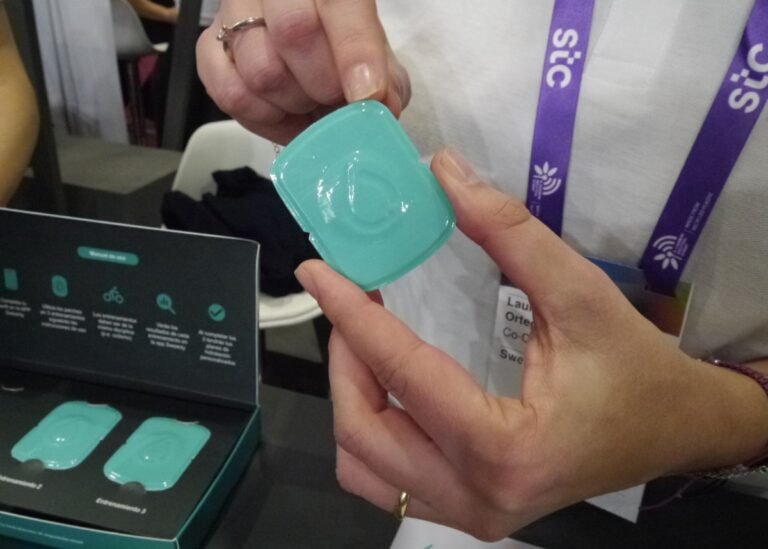Wearables come in a growing array of shapes, form factors and formats these days as health and fitness tracking proliferates. Here at 4YFN at the MWC trade show we spotted a new one: An athlete’s sweat monitoring patch to monitor salt loss and help them adjust their hydration strategy. The Spanish startup behind these (currently) disposable wearables is called Sweanty (yes, not a typo).
“We make personalized hydration plans for athletes — and those plans are based on their sweat analysis,” said co-CEO and founder Laura Ortrega Tañá, explaining that the system is designed to ensure athletes are hydrating with the right amount of electrolytes ( or isotonic drinks) after each workout. Analysis of the “sweat profile” of patch wearers is sent to a companion app where they access the customized hydration plan.
This means that the athlete must use a new patch each time they train. Or at least check in at key points during their training season (like when the temperatures change). Thus, the cost of monitoring will definitely increase. But professional athletes whose daily work pushes them to the edge are used to investing in their own performance.
Proper hydration can boost athletes’ performance by helping maintain energy levels and endurance, as well as reducing the risk of cramps, according to Ortrega Tañá. It can also help regulate temperature.
Sweanty’s wearables aren’t yet available for athletes to buy, but the startup expects to launch them in Spain by the end of April. Pricing is also unconfirmed — but suggests it will be in the region of €120 for a box of three patches (plus three months’ access to the subscription tracking service).
The version of the wearable shown here at MWC is designed to be worn on the skin at the base of the back. Trail runners are an early focus for the launch, but the patch could work for all kinds of endurance and performance sports. (Swimmers or other sports where the user is submerged are an exception; they should use manual methods to monitor salt loss, such as weighing before and after their session.)
The team is also working on an iteration of the patch that would allow the electronics to be retained after each use, with only part of the device having to be discarded after use.
The sweat analysis technology was developed and patented during Ortrega Tañá’s Ph.D. It highlights a paper-based method of salt measurement as a particular innovation here — with the device essentially waking up when it comes into contact with the wearer’s sweat.
“The type of measurement we do is with a paper-based method. We use a battery with two electrodes on a paper inside and when the paper is completely dry it doesn’t work. But when it absorbs sweat it gives strength that is directly related to the amount of salts involved,” he told TechCrunch.
While athletes are a fairly limited addressable market, Ortrega Tañá suggested the technology could have broader applications, such as for consumers who are physically fit and active enough to want to track their hydration. Or for worker safety use cases, such as for people working in very hot conditions, such as construction workers or firefighters, where there may be an occupational health hazard. “The only requirement we need is that they sweat,” he added.
Alerting caregivers to the risk of dehydration in seniors who may not be drinking enough is another potential use case he mentioned. However, in this scenario he said the wearable would need to be redesigned so it could actively stimulate the wearer’s sweat reflex so it could monitor them for salt loss.
